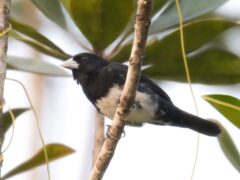The cone-billed tanager (Conothraupis mesoleuca) is a rare and elusive bird species endemic to Brazil. First described in 1939, it remained undetected for 65 years before its rediscovery in 2003 in Emas National Park, Goiás. Additional populations have since been identified, but its distribution remains highly fragmented. Due to habitat destruction and limited known populations, […]
Category: Thraupidae
How the Summer Red-Bird got his color
A Raccoon passing a Wolf one day made several insulting remarks, until at last the Wolf became angry and turned and chased him. The Raccoon ran his best and managed to reach a tree by the river side before the Wolf came up. He climbed the tree and stretched out on a limb overhanging the […]
Bird stories, Blue-black Grassquit and Blue-crowned Motmot
The Ch‘ol Maya believe the pich, identified by informants as variously the Melodious Blackbird (Dives dives) or Blue-black Grassquit (Volatinia jacarina), are said to sing to signal to a traveler that someone is ahead on the road. Hull, K. & Fergus, R. AN ETHNOORNITHOLOGICAL APPROACH TO HUMAN-BIRD RELATIONS AMONG THE MOPAN MAYA OF BELIZE. 2009. […]
The nest of the gold-ringed tanager (bangsia aureocincta), a colombian endemic
Gold-ringed Tanager (Bangsia aureocincta) Science Article 1 abstract We present the first nest description for the Gold-ringed Tanager (Bangsia aureocincta) and include notes on parental care. The nest is a large domed ball constructed of moss, whereas the nest lining is constructed of rootlets. We observed three adults attending the nest, the first evidence of […]
THE BREEDING CYCLE OF THE YELLOW-BELLIED SEEDEATER IN PANAMA
Yellow-bellied Seedeater (Sporophila nigricollis) Science Article 1 abstract This report on the Yellow-bellied Seedeater (Sporophila nigricollis) is part of a fiveyearstudy of the life histories of some common tropical birds of the Panama CanalZone. The species is widely distributed in the tropics and occurs in a variety of habitatsover a great range of altitude. On […]
A partly chestnut specimen of Variable Seedeater.
Wing-barred Seedeater (Sporophila americana) Science Article 2 abstract Navy pipeline near Gamboa, Panama Canal Zone, Horace Loftin and I collected an adult male Variable Seedeater (Sporophila aurita) with a considerable amount of chestnut in the plumage. There is a faint chestnut malar stripe and a narrow transverse band of chestnut across the throat. Storrs L. […]
When black plus white equals gray: the nature of variation in the Variable Seedeater complex (Emberizinae: Sporophila)
Wing-barred Seedeater (Sporophila americana) Science Article 1 abstract The degree of relationship between the Variable (Sporophila aurita) and Wing-barred (S. americana) Seedeaters has been debated for over 80 years. The discovery of a zone of hybridization between the former and the Gray Seedeater (S. intermedia), not previously considered to be closely related because of its […]
Ecological relationships between feather mites (Acari) and wild birds ofEmberizidae (Aves) in a fragment of Atlantic Forest in northeastern Brazil
White-lined Tanager (Tachyphonus rufus) Science Article 1 abstract The objective of this study was to investigate feather mites on birds of the Family Emberizidae, tocollect data on the ecological ectoparasite-host relationship and infestation level. A sum of 94 birds of 9 specieswas captured at the Refugio Ecologico Charles Darwin, Igarassu, Pernambuco, Brazil, from August 1996 […]
RAPTORS AND ‘CAMPO-CERRADO’ BIRD MIXED FLOCKLED BY Cypsnagra hirundinacea (Emberizidae:Thraupinae).
White-rumped Tanager (Cypsnagra hirundinacea) Science Article 1 abstract Bird mixed flocks including Cypsnagra hirundinacea and Neothraupis fasciata as species with sentinelswere studied in ‘campo-cerrado’ in order to investigate the possible relationship between alertnessand the mixed flock leadership. This study was conducted from March to September 1996 and mixedflocks were observed on average for 2:30h. The […]
Breeding Habits, Nestling Development, andVocalizations in the Summer Tanager
Summer Tanager (Piranga rubra) Science Article 3 abstract A pair of Summer Tanagers (Piranga rubra) nested near Zebulon, WakeCounty, N.C., in the spring of 1983. Nest contents were examined almost daily from 21May, the first day of incubation, through fledging of the young on 12 June. ELOISE F. POTTER, The Chat, 1985 Download article download […]

